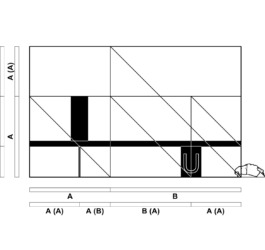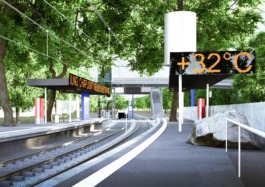




As the first German federal highway, the B1 crosses the Federal Republic of Germany from west to east. As the Ruhrschnellweg, it connects the most important cities of the Ruhr area; Duisburg, Mülheim an der Ruhr, Essen, Bochum and Dortmund. As Rheinlanddamm and Westfalendamm it forms one of the main traffic arteries of the city of Dortmund. As a section of the competition connects the center of Dortmund with the eastern outskirts of the city.
The design principle of the stops is geared to these different perceptions: The architectural elements of the bus stops are understood as unambiguous and self-confident signs that offer clarity, orientation and structure in an urban space characterized by high speed, noise and hectic. In this respect, they are abstracted into elements of perception in the sense of "minimal art“. The architectural elements are composed on a static level as "impure systems".
An "unbalanced", tension-rich architectural composition is brought back into static equilibrium with additive elements. In constant negotiation of design settings and static principles, the elements stand in a compelling relationship to each other. The clarity of the geometric bodies is contrasted with an "ambiguity" in the relationship of the elements to each other. However, the elements are held together again by a proportional overall order in the golden section.This play of balance and imbalance, the simultaneity of illogic and logic, generates an elusive architectural tension and gives the stations a multi-layered ambiguity. Each station works with different static principles that come together in the to form an overall narrative.




SWSTUDIO
| Spichernstrasse 59 | T +49 221 75959993 |
Program: Public Space tram Stops
Client: City of Dortmund
Status: Competition , 2nd Prize
Location: Dortmund
Year: 2020
Collaboration: Demo Working Group,
Rübsamen & Partner
Information

Program: Public Space tram Stops
Client: City of Dortmund
Status: Competition , 2nd Prize
Location: Dortmund
Year: 2020
Collaboration: Demo Working Group, Rübsamen & Partner
As the first German federal highway, the B1 crosses the Federal Republic of Germany from west to east. As the Ruhrschnellweg, it connects the most important cities of the Ruhr area; Duisburg, Mülheim an der Ruhr, Essen, Bochum and Dortmund. As Rheinlanddamm and Westfalendamm it forms one of the main traffic arteries of the city of Dortmund. As a section of the competition connects the center of Dortmund with the eastern outskirts of the city.
The design principle of the stops is geared to these different perceptions: The architectural elements of the bus stops are understood as unambiguous and self-confident signs that offer clarity, orientation and structure in an urban space characterized by high speed, noise and hectic. In this respect, they are abstracted into elements of perception in the sense of "minimal art“. The architectural elements are composed on a static level as "impure systems".
An "unbalanced", tension-rich architectural composition is brought back into static equilibrium with additive elements. In constant negotiation of design settings and static principles, the elements stand in a compelling relationship to each other. The clarity of the geometric bodies is contrasted with an "ambiguity" in the relationship of the elements to each other. However, the elements are held together again by a proportional overall order in the golden section.This play of balance and imbalance, the simultaneity of illogic and logic, generates an elusive architectural tension and gives the stations a multi-layered ambiguity. Each station works with different static principles that come together in the to form an overall narrative.



